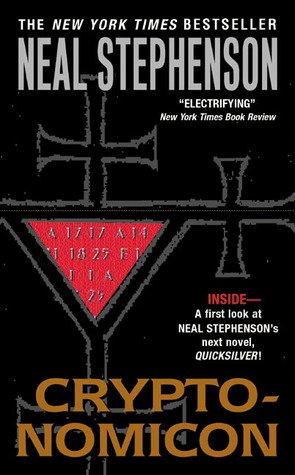@burnin book reviews: cryptonomicon

Mixing real, historical figures like Alan Turing with the fictional main characters, as well as real, historical events such as Operation Mincemeat, or Yamashita's Gold with events of fiction, it does a great job suspending your disbelief for the most bizarre parts of the story and leaving you wondering how much of the chronicled events are actually real.
Stephenson aims to be as technically accurate as possible. In fact, cryptographer Bruce Schneier created a new cryptosystem, called Solitaire, exclusively for the book. Solitaire has the interesting characteristic of being cryptographically strong while being able of being performed with a regular deck of playing cards, allowing covert secure communications where possession of crypto tools might be regulated by enemies or oppressive governments, a main plot point.
He doesn't save ink on this technical issues, either. Characters discuss cryptosystems, game theory, telecom, and other geeky subjects in detail, so the book is not for the faint of heart. A Perl implementation of Solitaire is included in full, curiously making the book export-restricted.
Neal also doesn't constrain himself in a traditional three-act story act: the 1000-page tome has many tangents, takes a long time to get started (you could say the first third is mostly setup for the actual story), is mostly devoid of a beginning, middle and end, and the story pivots almost as many times as does Epiphyte, their fictional startup. Still, one of my favorite chapters is a completely expendable one where one of the main characters devises an elaborate scheme to distribute the spoils of his late grandfather between him and his relatives by making an equivalence to the Knapsack Problem and spreading all the items in two dimensions in a parking lot:
"Well, that brings me to the breakthrough that Randy and Tom and Geoff and I finally came up with at about two A.M., namely that the perceived economic value of each item, as complicated as that is in and of itself, viz the Knapsack Problem, is only one dimension of the issues that have got us all on such a jagged emotional edge. The other dimension--and here I really do mean dimension in a Euclidean geometry sense--is the emotional value of each item. That is, in theory we could come up with a division of the set of all pieces of furniture that would give you, Nina, an equal share. But such a division might leave you, love, just deeply, deeply unsatisfied because you didn't get that console, which, though it's obviously not as valuable as say the grand piano, has much greater emotional value to you.
(...)
"Once we've all made our choices, then what? You sit down and figure it out on a spreadsheet, or something?"
"It is much too computationally intensive to be solved that way. Probably a genetic algorithm is called for--certainly there won't be a mathematically exact solution. My father knows a researcher in Geneva who has done work on problems isomorphic to this one, and sent him e-mail last night. With any luck we will be able to ftp some suitable software and get it running on the Tera."
"The Terror?"
"Tera. As in Teraflops."
It's not completely dry, though. Although I've been focusing on the geek, it has humor, romance (well, the kind of romance as a geek can write: at one point one of the characters posits that his lack of orgasms disturbs his technical work, and starts to plot his masturbation patterns) and adventure - lots of adventure, as much of the story happens in the middle of war zones.
So while the book could have been half as long and tell the same story, that's what makes it such an interesting read. It makes you keep thinking about war, history, cryptography, currencies, economy and other thought-provoking subjects for hours after you put down the book. And that's got to be a good thing.
Give this book a read if these subjects interest you. Don't be intimidated by its length, by the technical bits, or the lack of structure, and give it a shot - it takes a bit of patience, but it eventually gets where it needs to. It's not for everyone, but for those it is - it's a great read. It was for me.
liked this post? follow @burnin for more stuff like this
I'm reading it right now. It is good stuff indeed.
Great! After you finish don't forget to share your impressions!